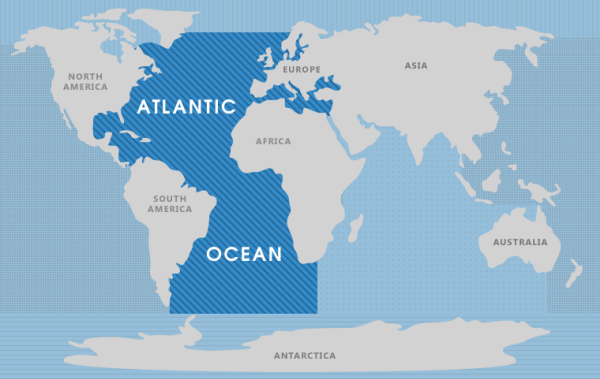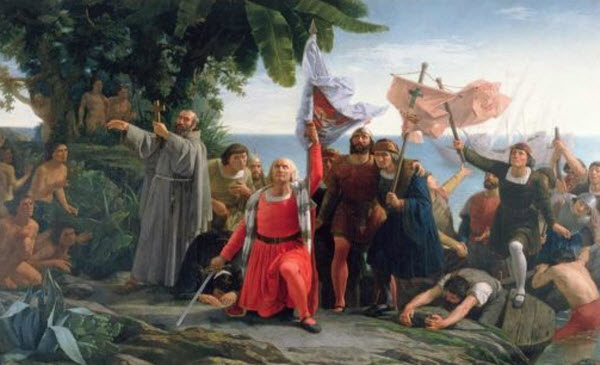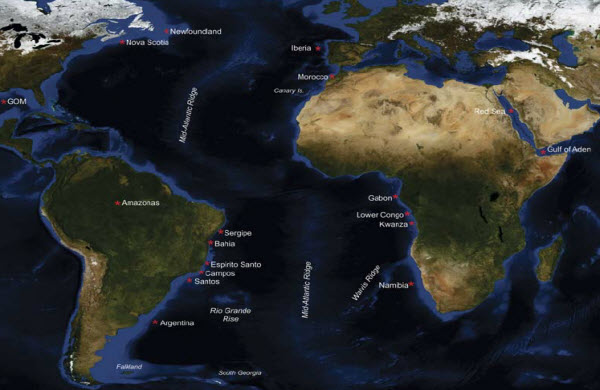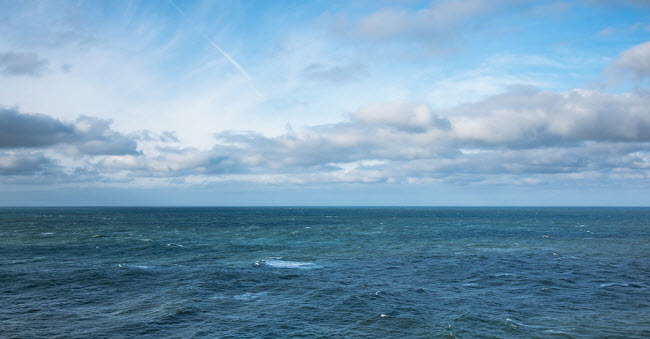The Atlantic Ocean is the second largest oceanic division on Earth, covering approximately one-fifth of its surface with a total area of 106.4 million square kilometers. Its name is derived from Greek mythology, and its earliest known mention was by the historian Herodotus in his work “Histories,” dating back around 450 BCE. It occupies an elongated S-shaped basin, stretching longitudinally between the Americas to the west and Eurasia and Africa to the east. To the north, it connects with the Arctic Ocean, to the southwest with the Pacific Ocean, and to the southeast with the Indian Ocean. Although it was the global center of trade during the colonial period and the 20th century, evidence suggests that such activities have increasingly shifted towards the Pacific Ocean in recent times. The Atlantic Ocean has played a crucial role in facilitating cultural, commercial, and political exchanges between the old and new worlds. Despite its vastness, its marine life faces significant threats from overfishing and pollution, prompting many nations to take effective measures such as developing aquaculture, implementing fishing regulations, and enacting laws to reduce pollution.

Historical Context of the Atlantic Ocean
The Vikings, the Portuguese, and Christopher Columbus are among the most notable early explorers of the Atlantic Ocean. Bjarni Herjolfsson, a Norse explorer from the 10th century, is considered the first known European to have sighted the mainland of the Americas in 986. He reported seeing low hills covered with forests from a distance to the west and found the land inviting. However, due to his desire to reach Iceland to see his parents, he did not land on these new lands. Upon his return, he reported his discoveries in Greenland and Norway, but there was little interest at the time. A decade later, Leif Erikson took these claims more seriously, acquiring the ship used by Bjarni and hiring a crew of 35 men to find the land. The Viking settlement in Vinland, located in Newfoundland, Canada, is believed to be the first known attempt at European colonization of the American mainland.
The first recorded Portuguese exploration of the Atlantic Ocean occurred in 1341, with the Canary Islands, known to the ancient Greeks as the Fortunate Isles, being the destination. The expedition successfully returned to Lisbon with four native people, fish oil, redwood, and hides. Despite this success, there was no immediate follow-up, and Portuguese projects were limited to coastal exploration and trade with North Africa, Europe, and the Mediterranean until the time of Prince Henry the Navigator. The Canary Islands became crucial as a supply station for voyages along the Canaries route, the shortest path to the west coast of Africa. One of Prince Henry’s early Atlantic voyages in 1420 resulted in the discovery of Madeira, which he aimed to colonize due to its uninhabited state and suitability for agriculture. By 1500, Madeira had become a significant sugar producer, heavily reliant on African slave labor. The Azores were discovered in 1427 and were also colonized by Prince Henry and his associates, contributing to wine production and agriculture. The discovery of Cape Verde Islands by Fernão Gomes in 1460 and São Tomé in 1470 continued this pattern of exploration and settlement.

Christopher Columbus, an explorer and colonizer, is known for his voyages that led to European awareness of the other hemisphere and the successful establishment of European cultures in the New World. On August 3, 1492, Columbus departed from Palos with three ships, first sailing to the Canary Islands for supplies and repairs. On September 6, he began a five-week voyage across the Atlantic, spotting land at 2 a.m. on October 12. Columbus named the island (now known as the Bahamas) “San Salvador,” though the indigenous people called it “Guanahani.” He also explored the northeastern coast of Cuba, landing on October 28. Columbus’s voyages accelerated European exploration, leading to the establishment of numerous new trade routes and making the Atlantic Ocean the primary artery between Europe and the Americas.
Key Historical Dates in the Atlantic Ocean
- 986: Norse explorer Bjarni Herjolfsson became the first known European to sight the American mainland.
- 1492: Christopher Columbus sailed west across the Atlantic Ocean.
- 1498: Portuguese navigator Vasco da Gama sailed along the Atlantic coast of Africa, around Africa to India, establishing a trade route.
- 1520: Ferdinand Magellan led an expedition from Spain across the Atlantic Ocean and around South America to the Pacific Ocean.
- 1553: An English expedition discovered the White Sea and established a trade route to Russia.
- 1858: Cyrus Field laid the first transatlantic telegraph cable.
- 1912: The Titanic sank after hitting an iceberg, resulting in the loss of 1,593 lives.
- 1919: The American NC-4 became the first aircraft to cross the Atlantic Ocean, despite making two stops along the way.
- 1919: A British aircraft completed the first non-stop flight across the Atlantic from Newfoundland to Ireland.
- 1921: British aviators made the first transatlantic flight in a balloon.
- 1922: Portuguese aviators completed the first flight across the southern Atlantic Ocean in a balloon.
- 1927: The first transatlantic telephone call was made.
- 1927: Charles Lindbergh completed the first solo non-stop transatlantic flight in a plane from New York to Paris, France.
- 1952: Ann Davidson became the first woman to sail solo across the Atlantic Ocean.
- 1994: Jay DeLancey was the first man to swim across the Atlantic Ocean from Cape Verde to Barbados.
- 1998: Benoît Lecomte became the first man to swim across the northern Atlantic Ocean, stopping for only one week in the Azores.
- 1999: Tori Murden became the first woman to row solo across the Atlantic Ocean, reaching Guadeloupe in the Caribbean from the Canary Islands after 81 days and 4,767 kilometers.
Geography of the Atlantic Ocean
The Atlantic Ocean is bordered to the west by North and South America, and to the north and northeast by the Arctic Ocean, separated by the Canadian Arctic Archipelago, Greenland, Iceland, Jan Mayen, Svalbard, and continental Europe. It connects through the Denmark Strait, Greenland Sea, Norwegian Sea, and Barents Sea. To the east, it is bounded by Europe and Africa, with the Strait of Gibraltar linking it to the Mediterranean Sea. To the southeast, it merges with the Indian Ocean at the 20-degree east longitude. To the south, it extends from Cape Agulhas to Antarctica. While some maps depict the Atlantic extending directly southward, others show it connecting with the Southern Ocean. To the southwest, it links to the Pacific Ocean via the Drake Passage, and the Panama Canal provides another link between the two oceans. Adjacent large water bodies include the Caribbean Sea, the Gulf of Mexico, Hudson Bay, the Mediterranean Sea, the North Sea, and the Baltic Sea.

The Atlantic Ocean has irregular coastlines interspersed with numerous bays and seas, including the Norwegian Sea, the Baltic Sea, the North Sea, Labrador Sea, the Black Sea, the Gulf of St. Lawrence, the Bay of Fundy, the Gulf of Maine, the Mediterranean Sea, the Gulf of Mexico, and the Caribbean Sea. It also includes islands such as Greenland, Iceland, the Faroe Islands, the British Isles (United Kingdom), Rockall, Newfoundland, Sable Island, the Azores, Madeira, Bermuda, the Canary Islands, the West Indies, Cape Verde, São Tomé and Príncipe, Annobón, St. Peter and Paul Rocks, Fernando de Noronha, Atol das Rocas, Ascension Island, Saint Helena, Trinidad and Tobago, Tristan da Cunha, Gough Island, the Falkland Islands, Tierra del Fuego, South Georgia, the South Sandwich Islands, and Bouvet Island.
The Atlantic Ocean and its adjacent seas cover an area of 106.4 million square kilometers, with an area of 82.4 million square kilometers excluding adjacent seas. Its volume, including adjacent seas, is 354.7 million cubic kilometers, and 323.6 million cubic kilometers without them. The average depth is 3,338 meters, with varying widths: the narrowest point between Brazil and Liberia is about 2,848 kilometers, while the widest extends 4,830 kilometers between the United States and North Africa.
Geology of the Atlantic Ocean
The main feature of the Atlantic Ocean floor is the submerged mountain range known as the Mid-Atlantic Ridge, stretching from Iceland in the north to approximately 58 degrees south latitude. Its maximum width is about 1,600 kilometers, with water depths over it reaching 2,700 meters in most areas. Several peaks rise above the surface to form islands. Some peaks divide the Mid-Atlantic Ridge into two major basins with depths ranging from 3,700 to 5,500 meters, while other ridges dividing the continents create numerous basins, including the Guyana, North America, Cape Verde, and Canary basins in the North Atlantic, and the Angola, Argentina, and Brazil basins in the South Atlantic.

The deep Atlantic Ocean floor is relatively flat, though it contains many seamounts and trenches, such as the Puerto Rico Trench in the north, the deepest at 8,605 meters, followed by the South Sandwich Trench in the South Atlantic at 8,428 meters, and the Romanche Trench near the equator at 7,454 meters. Ocean sediments consist of terrestrial, surface, and authigenic materials based on their origin and location on the seabed. Terrigenous sediments, primarily composed of sand, clay, and rock particles, accumulate on the continental shelves through erosion and river transport. Surface sediments, including remains of marine life such as shells and calcareous algae, form calcareous ooze or siliceous ooze depending on the dominant material. Authigenic sediments, produced by chemical reactions or biological processes in seawater, include manganese nodules and phosphorites.
The Atlantic Ocean’s boundaries, shaped by various geological features, influence its hydrographic and ecological conditions, affecting ocean currents, weather patterns, and marine life distributions. The interaction between these features creates diverse environments, from deep ocean trenches to expansive continental shelves, supporting a wide range of marine ecosystems.
Biology of the Atlantic Ocean
The Atlantic Ocean hosts diverse marine life, including a variety of fish species such as cod, herring, mackerel, and tuna, along with marine mammals like whales, dolphins, and seals. Coral reefs, though less extensive compared to the Pacific Ocean, are found in the Caribbean Sea and parts of the Gulf of Mexico. The Atlantic’s unique marine life is shaped by its complex geological features and varying environmental conditions, ranging from nutrient-rich upwellings to deep-sea habitats.
Climate and Oceanography
The Atlantic Ocean influences global climate patterns, particularly through the Atlantic Meridional Overturning Circulation (AMOC), a crucial component of the Earth’s climate system. The ocean’s surface temperature varies significantly, from the warm Gulf Stream and North Atlantic Drift in the North Atlantic to the cooler waters in the Southern Ocean and the Antarctic region. The Atlantic also experiences seasonal variations, with warmer temperatures in summer and cooler temperatures in winter.
The ocean’s currents, driven by wind patterns and temperature gradients, play a vital role in regulating global weather patterns and distributing heat. The Gulf Stream, for example, transports warm water from the Caribbean to the North Atlantic, affecting weather patterns in Europe and North America. The ocean’s salinity, influenced by precipitation, evaporation, and ice formation, also impacts its density and circulation patterns.

Economic Importance
The Atlantic Ocean is crucial for global trade, with major shipping routes connecting Europe, Africa, and the Americas. Ports along the Atlantic, such as New York, Rotterdam, and Santos, are among the busiest in the world, handling significant cargo volumes. The ocean also supports a thriving fishing industry, providing resources such as fish, shellfish, and seaweed.
Oil and gas exploration in the Atlantic, particularly in the North Sea and off the coast of Brazil, has become increasingly important, contributing to global energy supplies. Additionally, the Atlantic’s potential for renewable energy, including offshore wind and tidal power, is being explored as a sustainable alternative to fossil fuels.

Environmental Challenges
The Atlantic Ocean faces numerous environmental challenges, including pollution, overfishing, and climate change. Plastic pollution, oil spills, and chemical runoff from agriculture and industry threaten marine ecosystems and wildlife. Overfishing depletes fish stocks, disrupts food chains, and damages habitats. Climate change impacts, such as rising sea temperatures and ocean acidification, affect marine life and ecosystems.
Efforts to address these challenges include international agreements, conservation initiatives, and research programs aimed at protecting and preserving the Atlantic Ocean’s marine environment. Organizations such as the International Maritime Organization (IMO) and the United Nations Environment Programme (UNEP) work to implement policies and strategies for sustainable ocean management.
